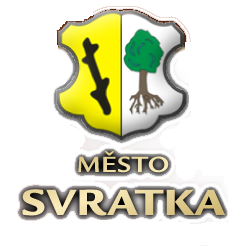Hiking
Svratka-Karlštejn. The tourist sign leads you from the centre past the Mánes Hotel to the golf course. After 2.5 km rising, the sign takes you to the hunting mansion called Karlštejn. In the years 1767-1776 it was built by the count Filip Kinský. However, he himself lived there only in the period of hunts of deer
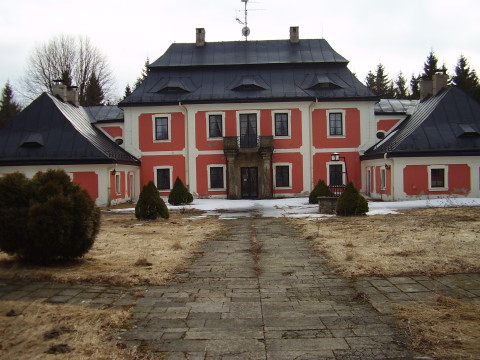
and boars. After selling the manor to the family of Thurn-Taxis in 1823, the mansion became a gamekeeper´s lodge. After 1945 the masion was nationalized, the owners (amign others, there were the Club of Czech Tourists and Gymnastic Club Spartak Svratka) took turns. From the 70s of the 20th century the mansion was being repaired by the firm OP Prostějov, which has a recreation centre there. Today is mansion a private object. Karlštejn hill with the mansion is known as „ the roof of Europe“ – there is a border of the main European watershead. flows either to the Black Sea or the North Sea from there. It is said that the watershed goes directly on the roof of the Karlštejn mansion.
Svratka-Kameničky (red toursit sign) – 5.5 kms
The red tourist sign goes from the centre of Svratka through the square past the church and along the asphalt road towards Chlumětín. You get to the village after 2.5 kms´ walk.
Chlumětín is a small village (190 people live there), first reported in 1392. The route passes the small chapel of Our lady from 1892. There is a grocery in the village, the pub is closed. There is a spring of the river Chrudimka above the village. After 2 kms along the asphalt road, you are in Kameničky.
The oldest written reference to Kameničky dates back to 1392. You can see the timbered cottages (highlanders used to lived there) with rich gables. Volák´s – or Vojtěch´s hill was often used by Antonín Slavíček as a motif of pictures that made the village famous in the same way as did K.V.Rais´s novel Západ (The Sunset). Both artists have their memorial tablets there. The Baroque church and the grave of the catholic rector Pardus (his name in the Rais´s novel was Kalous) are worth seeing. The outstanding Czech painters, mainly landscapers, from the turn of the 19th and 20th centuries (Herbert Masaryk, Angelo Zeyzer, Gustav Macoun, Miloš Jiránek, Otakar Nejedlý, Rudolf Kremlička) often came and worked there.
The memorial Gallery of Antonín Slavíček has been open there.
There is also a grocery and a pub in the village.
Svratka-Devět skal (the Nine Rocks) – yellow tourist sign – 6 kms
The route goes thorugh Svratka, over the river Svratka towards Moravská Svratka. There is the lovely
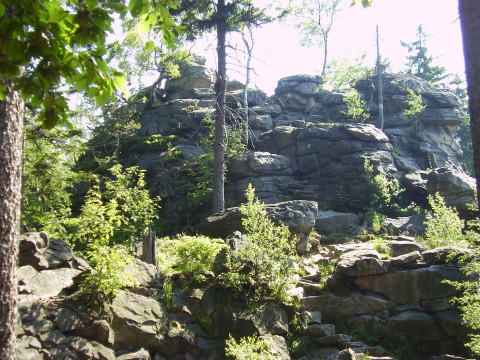
Devět skal
view of Svratka and Svratouch from the hill above the town. Tourists can walk through a deep, for the most part spruced, wood, which grows in the wavy grounds. With the rising height, there are more and more boulders and stones scattered in the wood. The stones gradually change into small islands of little rocks. The route goes mostly up hill southwards as far as the foot of Devět skal (the Nine Rocks), which is the highest point of the Žďár Hills in 836.3 metres above sea level. From the top, where a view point has been made, you can admire the countryside lying nothwards.
Svratka-Devět skal-Křižánky-Čtyři palice (the Four Hammers-rocks)-Karlštejn-Svratka (combined route) – 19.5 kms
The blue tourist sign leads you from Devět skal past Bílá skála (White Rock) to Křižánky. The first written reference to the village dates back to 1392, the village is divided in České Křižánky (left bank) and Moravské Křižánky (right bank) by the river Svratka. In 1960 both villages united. In 1886 the first skis appeared there. Those skis were brought by the forester Resch and the headmaster of the school
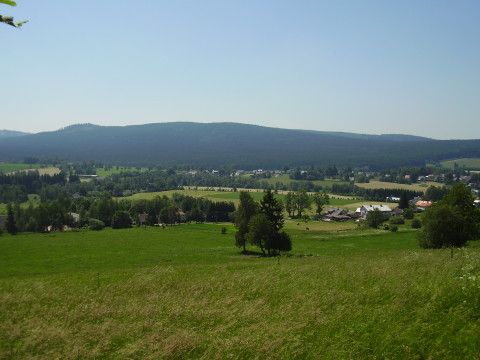
Houdek from Norway and were cleared at the customs as paddles. The village used to be well.known thanks to the production of files.
There is a grocery, the pub called „Za řekou“ (Behind the River), a bus connection on the lines Svratka.Nové Město na Moravě and Svratka-Polička.
Keep on the blue sign towards Čtyři palice (Four Hammers) on a steep way up to the top. Four Hammers is a rock formation having been modelled by the frost disintegrating and is surrounded by broken stones with a well-preserved wood in 732 metres above sea level. The tops of the rocks have the shapes of heads and are used as a training terrain for mountain climbers. Rocks are Nature Reserve with the area of 37.3 ha.
After one km´s walk you get to the Milovské/Velké Perničky in 757 metres above sea level. The rock formations having been created of three big a two small blocks, gradually put aside in the steep hill to the valley of the river Svratka. The rock pans on the tops – commonly called „perničky“ – originated from disintegrating used to be held for artificial objects with a cult function.
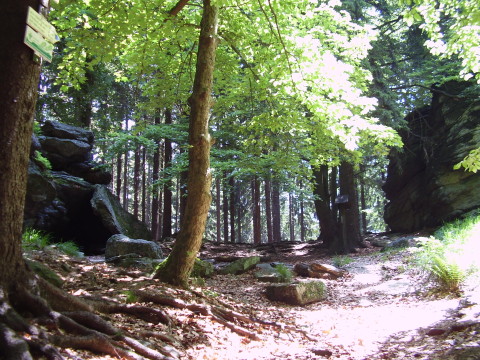
Zkamenělý zámek
Zkamenělý zámek (The Petrified Castle) to which we get after going up the steep hill, are there rocks suggesting a castle ruin. In the 6th – 8th centruries there used to be a settlement, the mounds and ditches can be seen even today. The palce was used as a settlement also in the Middle Ages. The archaeological excavations and finds from there are housed in the museums in Hlinsko and Svratka. After 2.5 kms´walking from Karlštejn down the hill, you get to the centre of Svratka.,
What to see in the neighbourhood of Svratka
Křižánky (5 kms) – The Memorial Reserve of Folk Architecture
Hlinsko (13 kms) – The Memorial of Folk Architecture Betlem, the complex of rural timbered cottages in the centre of the town, part of the open-air (skanzen) museum Vysočina. The Town museum and the Baroque Town Hall.
The open-air museum (skanzen) Vysočina (20 kms) – The complex of rural architecture of the northern part of Bohemian-Moravian Highlands.
Žďár nad Sázavou (22 kms) – The Church of St.John Nepomuciensis on Zelená Hora, the UNESCO memorial. The church built by the architect Jan Blažej Santini has the groundplan of a five-ended star.
Nové Město na Moravě (22 kms) – The highlader´s Museum – the exhibition of the crafts and skiing in the Highlands. The unique object there is the movabel „Little Mill from the village Vír“. The Highlanders´ Gallery houses works of many artists of the Highlands in the collections.
Jimramov (25 kms) – A little town with the pitoresque neighbourhood and with the spledidy-preserved square from the period of the Classicism.
Polička (25 kms) – A town with the preserved medieval walls, a bithpalce of the worldwide known composer Bohuslav Martinů. The little room in the church tower where he was born is open to public.
